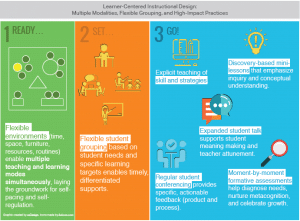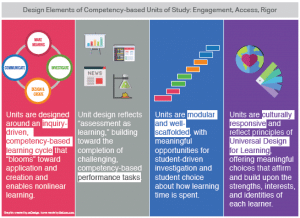3 Common Features of Competency-Based Systems that Meet Students Where They Are
CompetencyWorks Blog
This is the fourteenth post in the blog series on the report, Quality and Equity by Design: Charting the Course for the Next Phase of Competency-Based Education.
The field of education is in the midst of a dynamic process of innovation and redesign based on a stronger understanding of the learning sciences, maturation of a field of knowledge about how to best engage, motivate and build student agency, and how to use technology effectively within schools. For these reasons, the field is in the nascent stages of defining, in a concrete and comprehensive way, the distinguishing pedagogical practices that support a personalized approach to learning as compared to the one-size-fits-all of the traditional system.
In this blog, we offer examples to help practitioners operationalize a personalized approach in the academic realm. In mature competency-based schools, learners are active co-constructors of knowledge, rather than passive consumers of content. Learning is visibly and authentically connected to meaningful and important outcomes. Inquiry drives the learning process, as it does in the world beyond school. And finally, learning environments and experiences are purposefully designed to nurture the meta-cognitive, behavioral and motivational attributes of engaged, autonomous and adaptive learners. It is equally important for teachers to be thinking about where students are in terms of their ability as lifelong learners, including the ability to tap into a growth mindset, their social emotional skills, their metacognitive skills and the strength of their habits of success.
Competency-based schools that consistently and effectively meet students where they are have some common features. Below we offer a brief description of these features along with frequently used examples. More detail about these features and how they are used can be found in the report Meeting Students Where They Are. These are not exhaustive but offered to show how these features can be operationalized.
Common Feature 1: Learning Centered Classrooms Support Multiple Modalities
Students have access to multiple formats for learning. The physical organization of learning environments is flexible, allowing students to select the format that best meets their needs and is engaging. Classrooms may extend to outside of a school building. The teacher and student co-design the learning experience to ensure learning opportunities are maximized.
The graphic offers an illustration of this first element:

Common Feature #2: Responsive Facilitation of Learning in Action
Informed by the learning sciences, teachers have multiple strategies available for students to engage with the content and demonstrate what they have learned. Teachers are primarily facilitators of learning rather than the primary source of content expertise. Learning in responsive classrooms has two equally important goals — acquisition of knowledge and honing lifelong learning skills.
Common Feature #3: Learning Experiences that Foster Engagement, Access and Rigor
Learner-centered models that meet students where they are foster curiosity, agency and competence for all learners. Learning experiences reflect a commitment to addressing the needs, passions and experiences of all learners. In high-quality competency-based models, schools will be informed by the principles of Universal Design for Learning, cultural responsiveness and student agency.

In the next blog in this series, we will explore strategies to navigate system constraints in order to meet students where they are. Follow this blog series for more articles charting the course for the next phase of competency-based education, or download the full report:
- Quality and Equity by Design
- Readiness for College, Career and Life: The Purpose of K-12 Public Education Today
- Why A Competency-Based System Is Needed: 10 Ways the Traditional System Contributes to Inequity
- How Competency-Based Education Differs from the Traditional System of Education
- Competency-Based Education and Personalized Learning Go Hand-In-Hand
- Building Shared Understanding of Quality through Design Principles
- 5 Quality Design Principles for Culture
- 7 Quality Design Principles for Structure
- 4 Quality Design Principles for Teaching and Learning
- Designing a Competency-Based System for Equity
- An Equity Framework for Competency-Based Education
- Meeting Students Where They Are So That Everyone Masters Learning
- How Do We Know Where Students Are?
Learn more:
- Meeting Students Where They Are
- Readings on the Development of Children (2nd ed.)
- Universal Design for Learning (CAST)
- What Does It Mean to Meet Students Where They Are?
- Adolescent Trust in Teachers: Implications for Behavior in the High School Classroom (National Association of School Psychologists)
- Funds of Knowledge for Teaching: Using a Qualitative Approach to Connect Homes and Classrooms (JSTOR)